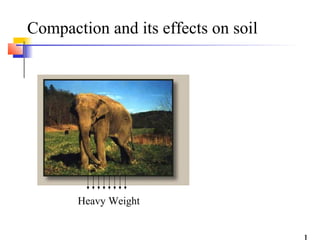
Compaction and its effects on soil
- 1. Compaction and its effects on soil Heavy Weight
- 2. 2.1 Compaction and Objectives Compaction • Many types of earth construction, such as dams, retaining walls, highways, and airport, require man-placed soil, or fill. To compact a soil, that is, to place it in a dense state. • The dense state is achieved through the reduction of the air voids in the soil, with little or no reduction in the water content. This process must not be confused with consolidation, in which water is squeezed out under the action of a continuous static load. Objectives: (1) Decrease future settlements (2) Increase shear strength (3) Decrease permeability
- 3. What is compaction? A simple ground improvement technique, where the soil is densified through external compactive effort. Compactive effort + water =
- 4. dough 2.2 General Compaction Methods Coarse-grained soils Fine-grained soils Laboratory •Vibrating hammer (BS) •Falling weight and hammers •Kneading compactors •Static loading and press •Hand-operated vibration plates •Motorized vibratory rollers •Hand-operated tampers Field •Rubber-tired equipment •Sheepsfoot rollers •Free-falling weight; dynamic compaction (low frequency •Rubber-tired rollers vibration, 4~10 Hz) Vibration Kneading (Holtz and Kovacs, 1981; Head, 1992)
- 5. 3. Theory of Compaction (Laboratory Test)
- 6. 3.1 Laboratory Compaction Origin The fundamentals of compaction of fine-grained soils are relatively new. R.R. Proctor in the early 1930’s was building dams for the old Bureau of Waterworks and Supply in Los Angeles, and he developed the principles of compaction in a series of articles in Engineering News-Record. In his honor, the standard laboratory compaction test which he developed is commonly called the proctor test. Purpose The purpose of a laboratory compaction test is to determine the proper amount of mixing water to use when compacting the soil in the field and the resulting degree of denseness which can be expected from compaction at this optimum water Impact compaction The proctor test is an impact compaction. A hammer is dropped several times on a soil sample in a mold. The mass of the hammer, height of drop, number of drops, number of layers of soil, and the volume of the mold are specified.
- 7. 3.1.1 Various Types Various types of compaction test 1 2 3 1: your test 2: Standard Proctor test 3: Modified Proctor test
- 8. 3.1.2 Test Equipment Standard Proctor test equipment Das, 1998
- 9. 3.2 Variables of Compaction Proctor established that compaction is a function of four variables: (1)Dry density (ρd) or dry unit weight γd. (2)Water content w (3)Compactive effort (energy E) (4)Soil type (gradation, presence of clay minerals, etc.) Height of Number of For standard Weight of hammer × drop of × blows per × Number of layer layers Proctor test hammer E= Volume of mold 2.495 kg (9.81m / s 2 )(0.3048 m)(3 layers)(25 blows / layer) E= 0.944 × 10−3 m3 = 592.7 kJ / m3 (12,375 ft ⋅lb / ft 3 )
- 10. 3.3 Procedures and Results (Cont.) Results Peak point Line of Zero air Dry density ρd (Mg/m3) Dry density ρd (lb/ft3) Line of optimum optimums void ρd max Zero air void Modified Proctor Standard Proctor wopt Water content w (%) Holtz and Kovacs, 1981
- 11. 4. Properties and Structure of Compacted Fine-grained Soils
- 12. 4.1 Structure of Compacted Clays • For a given compactive effort and dry density, the soil tends to be more flocculated (random) for compaction on the dry side as compared on the wet side. • For a given molding water content, increasing the compactive effort tends to disperse (parallel, oriented) the soil, especially on the dry side. Lambe and Whitman, 1979
- 13. 4.2 Engineering Properties-Permeability • Increasing the water content results in a decrease in permeability on the dry side of the optimum moisture content and a slight increase in permeability on the wet side of optimum. • Increasing the compactive effort reduces the permeability since it both increases the dry density, thereby reducing the voids available for flow, and increases the orientation of particles. From Lambe and Whitman, 1979; Holtz and Kovacs, 1981
- 14. 4.3 Engineering Properties-Compressibility At low stresses the sample compacted on the wet side is more compressible than the one compacted on the dry side. From Lambe and Whitman, 1979; Holtz and Kovacs, 1981
- 15. 4.3 Engineering Properties-Compressibility At the high applied stresses the sample compacted on the dry side is more compressible than the sample compacted on the wet side. From Lambe and Whitman, 1979; Holtz and Kovacs, 1981
- 16. 4.4 Engineering Properties-Swelling • Swelling of compacted clays is greater for those compacted dry of optimum. They have a relatively greater deficiency of water and therefore have a greater tendency to adsorb water and thus swell more. (wopt, ρd max) Higher Higher swelling shrinkage potential ρd potential w From Holtz and Kovacs, 1981
- 17. 4.5 Engineering Properties-Strength Samples (Kaolinite) compacted dry of optimum tend to be more rigid and stronger than samples compacted wet of optimum From Lambe and Whitman, 1979
- 18. 4.5 Engineering Properties-Strength (Cont.) The CBR (California bearing ratio) CBR= the ratio between resistance required to penetrate a 3-in2 piston into the compacted specimen and resistance required to penetrate the same depth into a standard sample of crushed stone. A greater compactive effort produces a greater CBR for the dry of optimum. However, the CBR is actually less for the wet of optimum for the higher compaction energies (overcompaction). Holtz and Kovacs, 1981
- 19. 4.6 Engineering Properties-Summary Dry side Wet side Structure More random More oriented (parallel) Permeability More permeable Compressibility More compressible in More compressible in high pressure range low pressure range Swell more, Swelling *Shrink more higher water deficiency Strength Higher Please see Table 5-1
- 20. 4.6 Engineering Properties-Summary (Cont.) Please find this table in the handout Holtz and Kovacs, 1981
Notes de l'éditeur
- Optimum water content is typically slightly less than the plastic limit.
